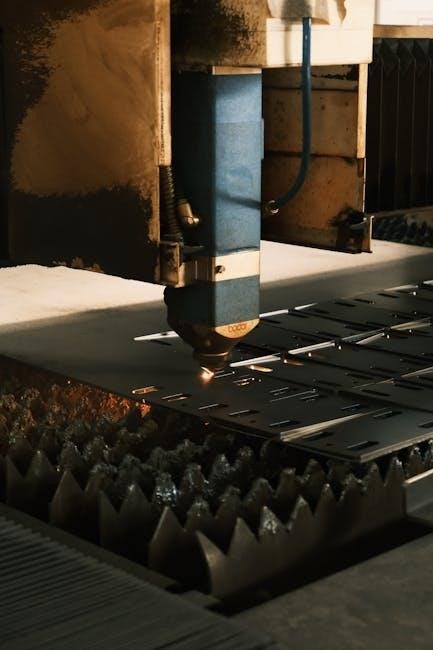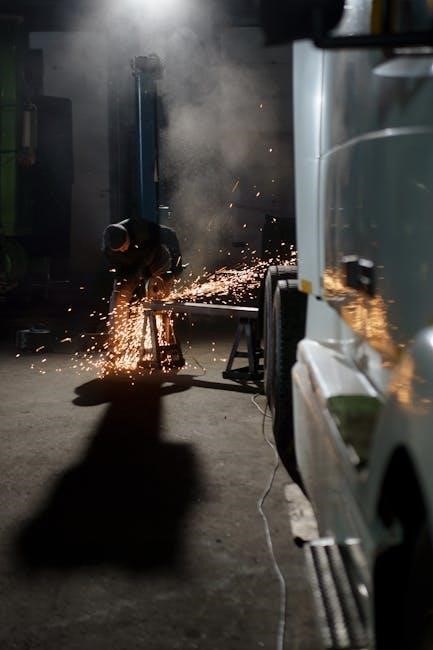Welding joins materials using heat or pressure, essential in manufacturing. It requires skill and knowledge. Resources like textbooks provide comprehensive guides for learning techniques and safety protocols effectively.
What is Welding?
Welding is a fabrication process that joins two or more materials—typically metals—by applying heat, pressure, or both. It creates a permanent bond between the materials, often with the addition of a filler metal. TIG, MIG, and arc welding are common techniques. The process melts the materials’ edges, fusing them together to form a strong joint. Welding is essential in manufacturing, construction, and repair industries. It offers high strength and durability, making it a versatile method for creating structures, machinery, and other equipment. Textbooks and guides provide detailed insights into various welding methods, safety protocols, and best practices for achieving precise and quality welds.
Importance of Welding in Manufacturing
Welding is a cornerstone of modern manufacturing, enabling the production of durable and complex structures. It is widely used in industries like automotive, aerospace, and construction to join metals and other materials efficiently. The process ensures strong, permanent bonds, which are critical for the integrity of machinery, vehicles, and buildings. Welding also supports cost-effective fabrication, allowing manufacturers to create customized products with minimal material waste. Its versatility and adaptability make it indispensable for meeting the demands of various industries. As manufacturing evolves, welding continues to play a vital role in driving innovation and maintaining high standards of quality and safety in production processes.
Types of Welding Processes
Various welding processes cater to different materials and applications. TIG (Gas Tungsten Arc Welding) is known for precision and cleanliness, ideal for thin metals. MIG (Gas Metal Arc Welding) offers high speed and versatility, suitable for both thin and thick materials. FCAW (Flux Cored Arc Welding) combines ease of use with strong welds, often used outdoors. SMAW (Shielded Metal Arc Welding) provides portability and simplicity, commonly used in construction. Resistance Welding, including Spot Welding, is widely used in automotive manufacturing for joining sheet metals. Each process has unique advantages, making them suitable for specific industries and materials, ensuring high-quality and durable joints in manufacturing applications.

Safety in Welding
Ensuring safety in welding involves using proper PPE, maintaining good ventilation, and following emergency procedures. Regular equipment checks and proper training are essential to prevent accidents and injuries.
Personal Protective Equipment (PPE)
Personal Protective Equipment (PPE) is essential for safeguarding welders from potential hazards. A welding helmet with a shaded lens protects the eyes and face from intense UV rays and sparks. Heat-resistant gloves prevent burns and improve grip on welding tools. Safety glasses or goggles provide additional eye protection when wearing a helmet. Flame-resistant clothing, such as jackets and pants, reduces the risk of fire-related injuries. Steel-toe boots and closed-toe shoes protect feet from heavy objects. Respirators or masks are crucial in environments with hazardous fumes. Proper PPE ensures a safe working environment and prevents severe injuries, making it a critical component of welding practices.
Workplace Safety Guidelines
Ensuring a safe welding environment requires strict adherence to workplace safety guidelines. The work area should be free from combustible materials and properly ventilated to prevent inhaling hazardous fumes. Fire extinguishers and emergency exits must be easily accessible. Welders should ensure all equipment is in good condition and properly grounded. Loose clothing and long hair should be secured to avoid entanglement with tools. Regular safety inspections and training sessions are essential to maintain awareness and compliance. Proper storage of welding materials and tools prevents accidents. Adhering to these guidelines minimizes risks and creates a secure workspace for all personnel involved in welding operations.
Hazardous Fumes and Ventilation
Welding processes generate hazardous fumes containing metals and gases, posing health risks. Proper ventilation is critical to remove these fumes and ensure a safe working environment. Local exhaust ventilation systems are recommended to capture fumes at their source. Inadequate ventilation can lead to respiratory issues and long-term health problems. Welders should use respirators when working in poorly ventilated areas. Regular maintenance of ventilation systems ensures their effectiveness. Keeping the workspace clean and free from contaminants reduces fume generation. Adhering to ventilation guidelines minimizes exposure to harmful substances, protecting both welders and nearby personnel. Always refer to safety guidelines for specific ventilation requirements based on the welding process.
Emergency Procedures in Welding
Emergency procedures are crucial in welding to address accidents promptly. Fire extinguishers and first aid kits must be readily available. In case of burns, immediately cool the affected area with water and seek medical help. Eye splashes require flushing with water and immediate medical attention. Fires should be extinguished using appropriate fire extinguishers. Welding areas must have clear escape routes and emergency exits. Regular safety drills ensure preparedness. Proper training on emergency procedures minimizes risks and ensures swift responses. Always maintain a clean and organized workspace to prevent accidents. Adhering to safety protocols is essential for protecting welders and others in the vicinity.

Welding Processes
Welding processes include diverse techniques like TIG, MIG, and arc welding, each using heat or pressure to join materials, with methods chosen based on material and desired outcomes.
Shielded Metal Arc Welding (SMAW)
Shielded Metal Arc Welding (SMAW), or “stick” welding, uses a flux-covered electrode to join metals. The flux protects the arc and weld area from contamination, producing a strong bond. Widely used for steel, it’s versatile across various industries, including construction and repair. SMAW is advantageous in outdoor or dirty conditions due to its tolerance of rusty or dirty surfaces. The process requires manual skill, as the welder controls the electrode and arc. Proper electrode storage is crucial to maintain weld quality. SMAW is detailed in welding textbooks, providing step-by-step guides and safety tips for mastering this fundamental technique. It remains a cornerstone in welding education and practice;
Gas Metal Arc Welding (GMAW)
Gas Metal Arc Welding (GMAW), also known as MIG welding, uses a continuous wire electrode fed through a welding gun; An inert gas shields the arc and molten weld pool, ensuring high-quality joints. GMAW is highly versatile, suitable for welding ferrous and non-ferrous metals like steel, aluminum, and stainless steel. It offers high-speed, low slag, and minimal post-weld cleanup. Common shielding gases include argon and CO2. GMAW is widely used in automotive, construction, and manufacturing industries due to its efficiency and precision. Welding textbooks detail its setup, techniques, and applications, making it a popular choice for both professionals and learners seeking to master this advanced welding process.
Gas Tungsten Arc Welding (GTAW)
Gas Tungsten Arc Welding (GTAW), or TIG welding, uses a non-consumable tungsten electrode to produce high-quality welds. An inert gas, typically argon or helium, shields the arc and weld pool, preventing contamination. GTAW is valued for its precision and ability to weld thin materials, making it ideal for stainless steel, aluminum, and other reactive metals. It offers superior control over weld penetration and appearance, with minimal slag. While GTAW is slower than GMAW, it excels in applications requiring high purity and aesthetic appeal, such as aerospace and automotive industries. Welding textbooks detail its techniques, making it a preferred method for skilled professionals seeking flawless joints and durability.
Flux Cored Arc Welding (FCAW)
Flux Cored Arc Welding (FCAW) uses a flux-cored electrode that produces a protective slag layer, eliminating the need for external shielding gas in some modes. This process offers high welding speeds and excellent penetration, making it ideal for thick materials. FCAW is versatile, suitable for both flat and vertical positions, and excels in outdoor conditions due to its reduced reliance on external shielding. It is widely used in construction and heavy fabrication for joining carbon steel and stainless steel. Welding textbooks highlight its dual-shield and gas-shield variations, emphasizing its adaptability and efficiency in various industrial applications, ensuring strong and durable welds with minimal post-weld cleanup required.
Spot Welding and Resistance Welding
Spot welding and resistance welding are processes that join materials using electrical resistance heat generated by passing current through the workpieces. Spot welding creates localized welds at specific points, ideal for thin materials like sheet metal. Resistance welding is highly efficient, often used in automotive and aerospace industries for assembling complex structures. These methods require minimal equipment and produce consistent results. Welding textbooks detail their applications, highlighting their suitability for high-volume production and precision joints. Both techniques ensure strong, durable bonds without filler materials, making them essential in modern manufacturing for achieving high-quality, repeatable welds efficiently and effectively, with minimal post-weld processing needed.

Materials and Their Weldability
Carbon steel, stainless steel, and aluminum are commonly welded materials, each with unique properties requiring specific techniques for successful joining. Proper material selection ensures durability and strength.
Carbon Steel Welding
Carbon steel is one of the most common materials welded due to its strength and cost-effectiveness. It is widely used in construction and manufacturing. Shielded Metal Arc Welding (SMAW) and Gas Metal Arc Welding (GMAW) are popular methods for carbon steel. Proper joint preparation and heat control are crucial to avoid distortion. Low-carbon steels are easier to weld, while high-carbon steels may require preheating to prevent cracking. Using the right filler metals ensures strong, durable joints. Post-weld cooling and inspection are essential to maintain quality. Carbon steel welding is fundamental in industrial applications, making it a key skill for welders. Proper techniques and safety measures ensure successful outcomes.
Stainless Steel Welding
Stainless steel welding is popular due to its corrosion resistance and durability. TIG welding is commonly used for its precision and ability to prevent contamination. Duplex stainless steels offer enhanced strength and resistance to pitting. Proper shielding gas and clean surfaces are essential to avoid impurities. Preheating may be required for certain grades to prevent warping. Welding processes like MIG and FCAW are also utilized, depending on the application. Techniques must ensure minimal heat input to maintain material properties. Stainless steel welding is critical in industries like food processing, medical equipment, and marine hardware. Resources such as welding handbooks and textbooks provide detailed guidance for optimal results.
Aluminum Welding
Aluminum welding requires careful techniques due to its high thermal conductivity and reactivity. TIG welding is often preferred for its precision and ability to handle thin materials. MIG welding is also used, offering higher speed and efficiency. Oxidation must be controlled, typically with argon shielding gas. Preheating can help prevent warping, while post-weld heat treatment may be needed for stress relief. Aluminum alloys like 6061-T6 are commonly welded in automotive and aerospace industries. Proper surface cleaning and filler metal selection are crucial to avoid porosity. Resources such as welding textbooks and guides provide detailed procedures to master aluminum welding techniques effectively.

Welding Techniques
Welding techniques involve precision and control, with methods like TIG, MIG, and arc welding. Proper joint preparation, heat control, and shielding gases ensure strong, contamination-free welds.
Joint Preparation and Design
Joint preparation and design are critical for achieving high-quality welds. Proper surface cleaning, alignment, and fit-up ensure minimal defects; Different joint types, such as butt, lap, and fillet, require specific designs. Cleanliness is essential to prevent contamination, with surfaces free from oil, rust, and debris. Precise alignment ensures even heat distribution, reducing distortion. Design considerations include material thickness, joint geometry, and accessibility for welding. Textbooks often provide detailed guides on preparing joints, emphasizing the importance of accurate fit-up and proper clamping. Improper preparation can lead to defects like porosity or lack of fusion. Adequate joint design enhances weld strength and durability, making it a cornerstone of successful welding processes.
Welding Positions and Joint Fit-Up
Welding positions and joint fit-up significantly impact weld quality. Proper alignment and fit-up ensure even heat distribution, reducing distortion. Textbooks detail various welding positions, such as flat, horizontal, vertical, and overhead, each requiring specific techniques. Joint fit-up must be precise to maintain consistency and avoid gaps. Correct positioning enhances accessibility, allowing better control over the weld pool. Improper fit-up can lead to defects like slag inclusions or lack of penetration. Textbooks emphasize the importance of clamping and fixturing to hold joints securely. Understanding welding positions and achieving accurate fit-up are essential skills for producing strong, defect-free welds in various industrial applications.
Controlling Heat Input and Distortion
Controlling heat input is crucial to prevent distortion and ensure high-quality welds. Excessive heat can cause warping or residual stresses, weakening the structure. Techniques like preheating, post-heating, and cooling rates help manage heat distribution. Textbooks highlight the importance of adjusting welding speed and current to maintain optimal heat input. Proper joint design and fit-up also minimize distortion. Clamping and fixturing techniques are essential to hold components in place, reducing movement during welding. Textbooks provide detailed guidance on heat control strategies, ensuring weld integrity and dimensional accuracy in various materials and applications.

Welding Equipment and Tools
Welding requires specialized tools like welding machines, electrodes, helmets, and hand tools. These ensure precise, safe, and efficient joining of materials in various welding processes;
Welding Machines and Power Sources
Welding machines are essential for generating the electrical current needed to create welds. They vary in type, including AC/DC TIG welders, MIG welders with constant voltage, and multi-process machines. Power sources are designed to deliver precise current control, ensuring consistent weld quality. Advanced machines often feature digital controls and adjustable parameters like voltage and wire feed speed. Portability and duty cycle are key considerations for industrial and field applications. Selecting the right machine depends on the welding process, material type, and thickness. Modern welding machines also incorporate safety features, such as overload protection and thermal monitoring, to prevent damage and ensure operator safety during operation.
Electrodes and Filler Metals
Electrodes and filler metals are critical components in welding, determining weld quality and mechanical properties. Shielded metal arc welding (SMAW) uses consumable electrodes coated with flux, while gas metal arc welding (GMAW) employs continuous wire electrodes. Filler metals are selected based on the base metal’s composition to ensure compatibility and desired strength. Electrodes vary in types, such as stainless steel, carbon steel, and aluminum, each suited for specific applications. Proper storage and handling of electrodes are essential to maintain their quality and performance. The choice of electrode and filler metal significantly impacts weld penetration, corrosion resistance, and tensile strength, making their selection a key step in welding processes.
Welding Helmets and Accessories
Welding helmets protect the face, eyes, and neck from sparks, spatter, and harmful UV/IR radiation. Modern helmets feature auto-darkening filters (ADF) that adjust shade levels based on welding conditions, enhancing visibility and comfort. Passive helmets with fixed shade lenses are also available. Accessories like lens shade variations, respirators, and cooling systems improve safety and productivity. Additional gear includes welding gloves, sleeves, and fire-resistant clothing to ensure comprehensive protection. Helmets with built-in grind modes and magnifying lenses cater to specific tasks. Proper maintenance and selection of helmets and accessories are crucial for optimal safety and performance in all welding environments, ensuring compliance with industry standards and regulations.

Testing and Inspection
Weld quality is verified through visual inspection, non-destructive testing (NDT), and destructive methods. Techniques like radiography and ultrasonic testing detect internal defects, ensuring structural integrity and safety standards compliance.
Visual Inspection of Welds
Visual inspection is the first step in evaluating weld quality. It involves examining the weld’s surface for defects like cracks, porosity, or slag inclusions. Proper lighting and tools, such as magnifying glasses, enhance accuracy. Surface contamination, spatter, or uneven bead profiles are also assessed. This method is non-destructive and cost-effective, providing immediate feedback on workmanship and adherence to specifications. Regular visual checks help identify issues early, preventing costly repairs. It is a critical component of quality control in welding processes, ensuring structural integrity and safety. By addressing visible flaws, visual inspection contributes significantly to maintaining high standards in fabricated products.
Non-Destructive Testing (NDT) Methods
Non-destructive testing (NDT) methods are essential for evaluating weld quality without causing damage. Common techniques include radiographic testing (X-ray or gamma-ray inspection), ultrasonic testing, magnetic particle testing, and liquid penetrant testing. These methods detect internal or surface defects like cracks, porosity, or lack of fusion. Radiographic testing provides detailed images of the weld’s internal structure, while ultrasonic testing uses sound waves to identify discontinuities. Magnetic particle testing reveals surface and subsurface cracks in ferromagnetic materials. Liquid penetrant testing highlights surface defects through color contrast. NDT ensures weld integrity, safety, and compliance with standards, making it a critical step in quality control processes for industrial applications.

Common Welding Defects
Defects like porosity, slag inclusions, cracks, and lack of fusion can weaken welds. Addressing these issues ensures strength and reliability in fabricated structures.
Porosity and Slag Inclusions
Porosity refers to small cavities or gas traps within the weld, often caused by gases escaping during solidification. Slag inclusions occur when slag particles are entrapped in the weld pool. Both defects weaken the weld, reducing its strength and durability. Porosity can result from improper shielding gas flow, moisture, or contamination. Slag inclusions are often due to insufficient cleaning between weld passes or poor technique. These defects can be minimized by ensuring proper joint preparation, maintaining a clean work area, and using correct welding parameters. Regular inspection and non-destructive testing help identify such issues early, ensuring high-quality welds and structural integrity.
Cracks and Lack of Fusion
Cracks and lack of fusion are common welding defects that compromise weld integrity. Cracks occur due to thermal stresses, poor joint design, or improper cooling rates. Lack of fusion happens when the weld fails to fully penetrate or bond with the base metal. Both issues often result from incorrect welding parameters, such as insufficient heat input or improper technique; They can also stem from contaminants or uneven heating. Addressing these defects requires careful inspection, proper equipment calibration, and adherence to welding procedures. Techniques like preheating and postheating can help prevent cracks, while ensuring adequate penetration and cleaning the joint can mitigate lack of fusion.
Weld Spatter and Surface Contamination
Weld spatter and surface contamination are common issues in welding that can lead to defective welds. Spatter occurs when molten metal droplets are ejected during the welding process, sticking to the surrounding surface. Contamination can result from dirt, oil, moisture, or other substances on the base metal. Both problems can weaken the weld and require costly repairs. Proper cleaning of the workpiece before welding, using the correct shielding gas, and maintaining proper welding techniques can minimize spatter and contamination. Regular cleaning and the use of anti-spatter sprays are also effective solutions. Ensuring a clean, dry workspace and wearing appropriate PPE further reduces contamination risks.

Resources for Learning Welding
Various welding textbooks and PDF guides offer comprehensive insights into welding techniques, safety, and best practices. TIG welding PDFs and books like Welding For Dummies are popular choices for beginners. Online platforms provide free downloadable resources, such as the American Welding Society handbook, ensuring accessible learning for welders of all skill levels.
Best Welding Textbooks for Beginners
For those starting their welding journey, textbooks like Welding For Dummies by Steven Robert Farnsworth and Applied Welding Engineering are highly recommended. These books provide detailed explanations of welding principles, safety practices, and hands-on techniques. They cover various welding processes, including TIG, MIG, and arc welding, making them comprehensive guides for novices. Many of these textbooks are available as PDFs, offering convenient access to learning materials. They emphasize the importance of proper equipment usage and joint preparation, ensuring a strong foundation for beginners. These resources are invaluable for understanding the fundamentals and advancing welding skills effectively.
Online Courses and Tutorials
Online platforms like Udemy and Coursera offer comprehensive welding courses suitable for beginners. These tutorials cover fundamental techniques, safety protocols, and advanced methods. Many courses include video demonstrations, interactive exercises, and downloadable PDF materials. They emphasize hands-on practice and theoretical knowledge, ensuring a well-rounded learning experience. Topics range from basic MIG and TIG welding to specialized processes like arc welding. These resources are ideal for self-paced learning, allowing students to master welding skills at their convenience. Additionally, some courses provide certification upon completion, enhancing professional credentials. They are a valuable supplement to traditional textbooks, offering flexible and accessible education for aspiring welders.
Free Welding PDF Guides and Manuals
Various free welding PDF guides and manuals are available online, offering detailed insights into welding techniques. These resources cover topics like TIG, MIG, and arc welding, along with safety practices. Websites provide access to downloadable materials, such as the “Welding Handbook” and “Applied Welding Engineering,” which are invaluable for both beginners and professionals. Many of these guides include diagrams, step-by-step instructions, and troubleshooting tips. They are often shared by educational institutions and industry experts, ensuring quality and relevance. These free resources are a great way to enhance welding knowledge without additional costs, making them accessible to a wide audience seeking to improve their skills.

Applications of Welding
Welding is crucial in automotive, aerospace, and construction industries for creating durable structures. It is also essential for industrial machinery repair, ensuring efficiency and versatility in manufacturing processes.
Automotive and Aerospace Industries
Welding plays a pivotal role in the automotive and aerospace industries, enabling the fabrication of lightweight yet durable components. In automotive manufacturing, welding is used to assemble car bodies, frames, and engine parts, ensuring structural integrity and safety. Similarly, in aerospace, advanced welding techniques like TIG and MIG are employed to construct aircraft fuselages, wings, and engine components, where precision and strength are critical. The use of high-strength, corrosion-resistant materials, such as stainless steel and aluminum alloys, is common in these industries. Welding ensures the production of reliable, high-performance vehicles and aircraft, making it indispensable in these sectors.
Construction and Shipbuilding
Welding is integral to construction and shipbuilding, enabling the creation of robust structures. In construction, welding is used for building frameworks, bridges, and high-rise buildings, ensuring durability and stability. Shipbuilding relies on welding to construct hulls, decks, and superstructures, with techniques like Shielded Metal Arc Welding (SMAW) and Flux Cored Arc Welding (FCAW) being common; The use of high-strength, corrosion-resistant materials ensures longevity in marine environments. Advanced welding processes, such as Gas Metal Arc Welding (GMAW), enhance efficiency in large-scale shipbuilding projects. Safety and precision are critical, as defective welds can lead to structural failures. Welding’s versatility and strength make it essential for these industries.
Industrial Machinery and Equipment Repair
Welding plays a crucial role in the repair and maintenance of industrial machinery and equipment. It ensures that damaged or worn components are restored to their original strength and functionality. Techniques like TIG and MIG welding are commonly used for precise repairs, especially in intricate machinery parts. Proper material selection and adherence to safety protocols are essential to avoid contamination and ensure durability. Regular maintenance welding prevents costly downtime and extends equipment lifespan. Resources such as welding textbooks provide detailed guides for troubleshooting and executing repairs effectively, making them invaluable for professionals in this field. This ensures industrial operations remain efficient and reliable.
